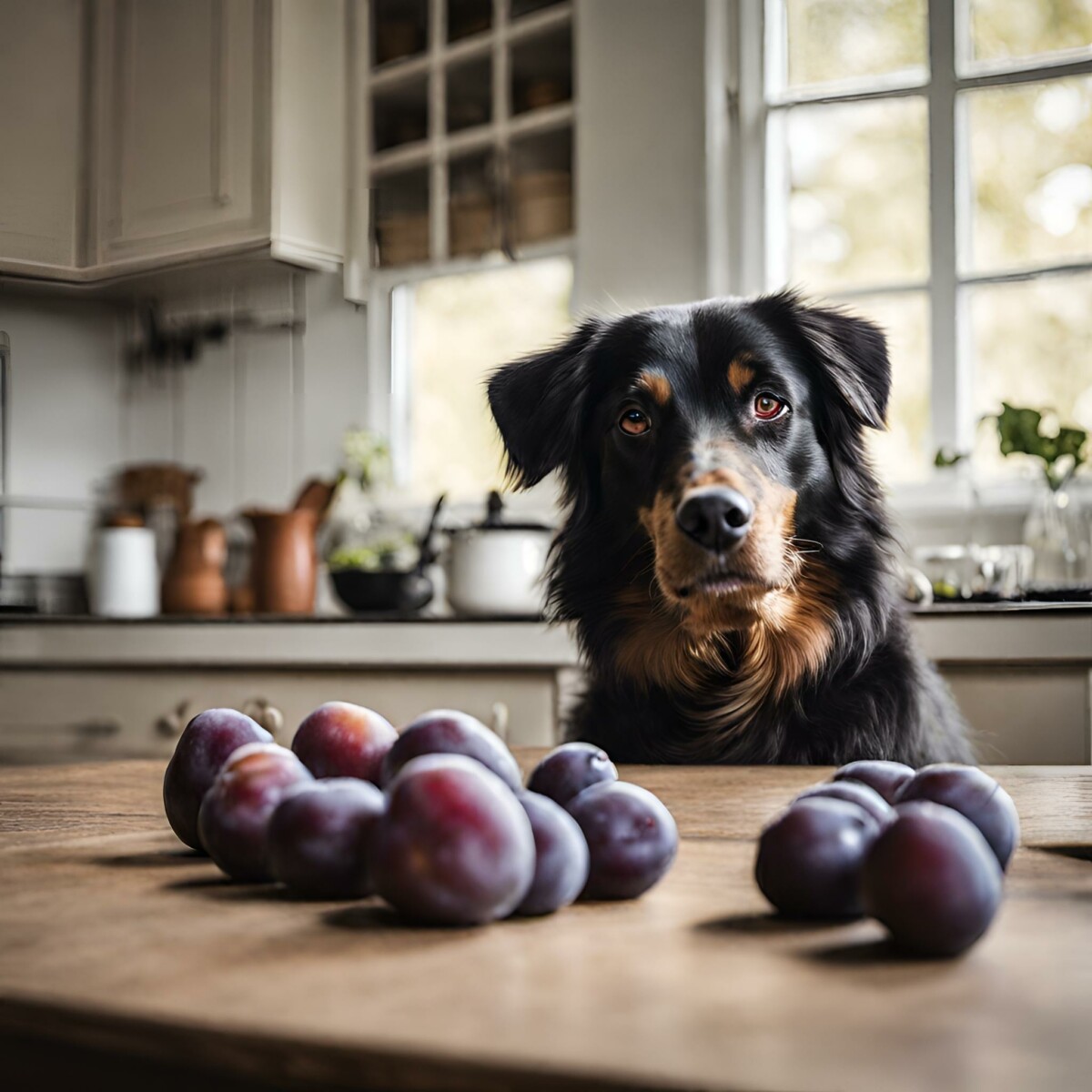Plums are those delightful, colorful fruits that tempt humans during summer. Their sweet and tangy taste makes a tasty, nutritional snack. But what about our best friends?
Can dogs eat plums?
The short answer is yes, but there are a few precautions you need to know about. Let’s discuss the pros and cons of sharing plums with your pup if you have a few minutes.
Can Dogs Eat Plums
Yes, the fruit’s flesh is generally safe, but you should avoid feeding your dog the plum pit and skin. Plum pits contain cyanide, which can be harmful if ingested. The skin can be difficult for dogs to digest and may lead to gastrointestinal issues.
While plums offer health benefits due to their richness in vitamin C, iron, fiber, antioxidants, and polyphenols, their high sugar content necessitates careful moderation when feeding them to dogs, especially those with diabetes.
Over time, repeated consumption of large sugar quantities can lead to diabetes in dogs. Therefore, exercise caution when sharing plums with your canine companion. To ensure their safety, provide only ripe plum flesh in small portions and always remove the stone before offering it to them.
Can Dogs Eat Plums: Table of Contents
The Risks of Feeding Dogs Plums
Despite their rich nutritional components, plums also come with a few potential risks that we need to be mindful of when feeding dogs. Here are some of the cons of feeding plums to your four-legged friends:
Pits or Stones: The most significant concern regarding plums and dogs is the pit or stone. These little guys can be a choking hazard and, if swallowed, may cause intestinal blockages. So, the first rule of thumb is always to remove the pit before offering a plum to your dog.
Sugar Content: Plums are sweet, no doubt about it. While some natural sugar can be okay for dogs, too much can lead to weight gain and dental issues. Remember, moderation is key! Don’t overindulge your pup with plums.
Skins: The skin of plums may be a bit tough to digest for some dogs, especially if they have sensitive stomachs. Peeling the plum before giving it to your dog can help reduce the risk of tummy troubles.
If you are looking for other fruits that might be a better option than plums, here are some other fruits you can share with your pup:
- Apples.
- Bananas.
- Blueberries.
- Cantaloupe.
- Cranberries.
- Mango.
- Oranges.
Nutritional Benefits of Plums for Dogs
Plums are packed with essential vitamins and minerals, making them a nutritious treat for humans and dogs.
- Vitamin C: Plums are a great source of vitamin C, boosting your dog’s immune system. Consistent consumption of vitamin C can also help reduce cognitive aging and reduce the risk of inflammation.
- Fiber: Plums’ dietary fiber can aid digestion and regulate bowel movements.
- Antioxidants: Plums are rich in antioxidants, helping combat harmful free radicals in your dog’s body.
- Plenty of sugar: Plums contain some naturally occurring sugar that can help stabilize sugar levels in the blood, especially if you’re trying to avoid feeding sweet treats to your dog and want a healthier option.
Plums: Nutritional Table
| Plums | 3.53 oz/100 g |
| Total fat | 0.3 g |
| Saturated fat | 0.01 g |
| Total carbohydrate | 11 g |
| Dietary fiber | 1.4 g |
| Sugar | 10 g |
| Protein | 0.7 g |
| Potassium | 157 mg |
| Sodium | 0 mg |
| Vitamins, minerals, etc. | % daily value |
| Vitamin C | 15% |
| Magnesium | 1% |
| Iron | 1% |
| Calcium | 5% |
| Total calories | 46 |
Precautions and Safety First
Now that you know the pros and cons of feeding plums to your dog, here are some of the most important precautions to keep in mind when feeding plums to your pup:
Wash thoroughly: Make sure to wash the plum thoroughly to remove any pesticides or chemicals that may be present.
Small servings: Instead of giving your dog a whole plum, consider slicing it into small, manageable pieces to reduce the risk of choking.
Supervision: When introducing any new food to your dog’s diet, always supervise them. This way, you can quickly react to any problems.
Allergies: Just like humans, dogs can have allergies too. If your dog has never had plums, start feeding them to your pup in small amounts and only occasionally.
Homemade Plum Recipe For Dog Treats
Do you want to make a special treat with plums for your dog instead of plain, raw plums? Don’t worry – I got you covered.
Here’s a quick and straightforward homemade recipe for blueberry-based dog treats:
Ingredients:
- 1 cup fresh plums, pitted and diced – always remove the seeds and peel off the skin!
- 2 cups whole wheat flour
- 1 egg
- 1/4 cup water
- 1/4 cup plain Greek yogurt
Instructions:
- Preheat your oven to 350°F (175°C) and line a baking sheet with parchment paper.
- In a mixing bowl, beat the egg and add the diced plums. Give it a good stir to combine.
- Gradually add the whole wheat flour to the egg and plum mixture. Keep stirring until it forms a dough-like consistency. If it’s too dry, add a little water, one tablespoon at a time.
- Roll out the dough on a floured surface to about 1/4-inch thickness. You can use a rolling pin or just flatten it with your hands.
- Use cookie cutters or a knife to cut out fun shapes for your dog’s treats. Place them on the prepared baking sheet.
- Pop those plastic treats in the oven and bake for about 20-25 minutes or until they turn golden brown and crisp.
- Let the treats cool on a wire rack. Once they’re cool, you can spread a thin layer of plain Greek yogurt on top.
- Now, it’s time to treat your four-legged friend!
VET Q&A
How Much Plums is Too Much?
The answer varies depending on your dog’s size and individual tolerance. As a general rule, limit the plum amount to a few small, bite-sized pieces. Start with a tiny amount and observe how your dog reacts.
If you notice any serious reactions like diarrhea or upset stomach, it’s best to skip plums altogether.
What Should You Do If Your Dog Eats a Plum Pit?
The safest solution is to contact your veterinarian and seek professional advice immediately. Plum pits are toxic to dogs because they contain cyanide – a chemical that’s poisonous to dogs. And even if a dog doesn’t swallow the pit, it can still lead to cyanide poisoning in dogs.
Some of the most common symptoms of cyanide poisoning are:
- drooling,
- watery eyes,
- loss of appetite, etc.
Also, there’s always a risk of choking, damage to the throat and teeth, or even tummy pain – it’s better to be safe than sorry.
Is It Okay For Dogs To Eat Dried Plums/Prunes?
The answer is no. Even though prunes are just dried forms of plums (note that not every type of plum can be dried), they contain a lot of sugar and a really high level of fiber.
Too much sugar and fiber makes them unhealthy and if a dog consumes a high amount, it can lead to loss of appetite, vomiting, and diarrhea.
Can Dogs Eat Plums With Skin?
No. plum skin is much more difficult to digest and poses a higher chance of choking than the actual flesh of the fruit.
My Senior Paws is a participant in the Amazon Services LLC Associates Program, an affiliate advertising program designed to provide a means for sites to earn advertising fees by advertising and linking to Amazon.com. We also participate in other affiliate programs which compensate us for referring traffic.




